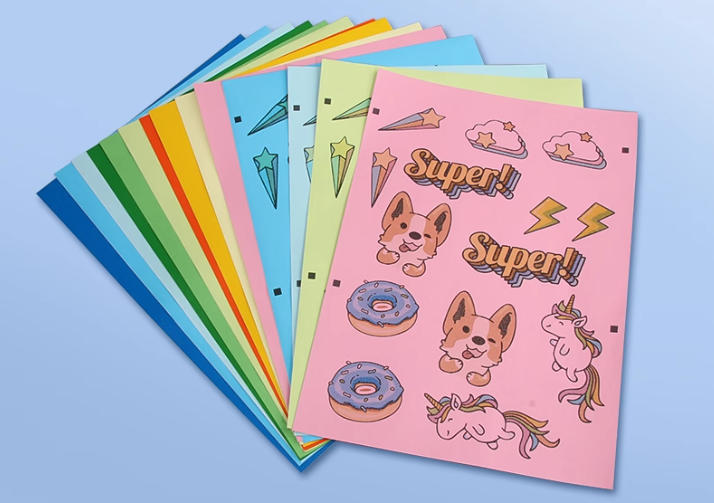Self-adhesive labels come in many varieties, including copperplate, book paper, and synthetic paper. They are convenient and widely applicable, offering easy application, durability, and quick results with minimal investment. During the Sticker Label printing process, several issues must be avoided. First, pay attention to printing pressure, which significantly impacts print quality. Secondly, consider the printing plate. Avoid excessively small spacing, which can lead to blurred prints. Be mindful of issues such as haloing during printing.

I. Common Problems with Self-Adhesive Label Printing
1. Pressure Effects: Printing pressure significantly impacts print quality. Maintaining a consistent and uniform printing pressure within the ineffective printing area not only ensures uniform ink color and minimizes color variation, but also ensures consistent print size. Flatbed printing presses can achieve the highest possible printing pressure. However, due to manufacturing precision, plate flatness, and the thickness of the adhesive substrate, uneven pressure can affect print quality. One way to address uneven pressure is to use padding: padding the work surface where pressure is low. Another approach is to appropriately reduce the hardness of the flexographic plate. However, there’s no limit to how much this can be achieved. If the hardness is too low, the image and text will expand outward, blurring large fonts. When printing on large areas, the issue of printing pressure is more difficult to address. A similar approach can be used for hot stamping: padding the work surface with a 175-line screen-printed silicone rubber plate with a hardness of 90°. This can address the issues of venting and localized pressure.
2. Smudged plate. For text in sizes smaller than size 8, due to the small fine line spacing, the ink often dries underneath, making the text and images blurry. This is usually caused by the ink drying too quickly. If this occurs, the problem should first be addressed within the flexographic resin plate itself. Generally, the bottom of the font on a resin plate should feel smooth and not sticky. However, due to insufficient exposure, the bottom of the font becomes sticky and soft, making it easy for ink to stick to the bottom, causing it to accumulate and dry outside the fine lines. If the plate is discarded, it will be a waste of material. In this case, a resin plate post-treatment solution containing sodium hypochlorite and hydrochloric acid can be used to harden the base of the characters and eliminate any stickiness. The basic method is to develop an exposure time to produce a resin plate that meets the specifications. For particularly fine fonts, it is recommended to switch to a copper-zinc plate. The ink between the characters on the copper-zinc plate is less likely to dry out, the characters are more durable, and it is easier to print clear strokes. Regarding the operating environment, it is important to minimize air convection. If this is not effective, add an appropriate retarder to the ink to slow the drying process. Properly increasing the printing speed can prevent the ink from drying out excessively.
3. Haloing. Sometimes, a cloud-like shadow appears on self-adhesive products. This is usually caused by uneven ink distribution. The inking roller in flatbed self-adhesive printing is a chrome-plated iron roller with a diameter of 150mm that can move axially. Its function is to receive ink from the ink fountain roller and the ink transfer roller, evenly distribute the ink, and then transfer it to the inking roller. The ink distribution effect of the inking roller can easily cause haloing. Furthermore, the inking roller is made of soft vulcanized nitrile rubber. If not properly maintained, inking efficiency will decline and cause haloing. Addressing haloing is to address uneven ink distribution by appropriately increasing the ink supply.
4. Synchronization of die-cutting and printing. Self-adhesive labels typically require cutting to a specific shape before use. On a press that combines printing and die-cutting, synchronization between die-cutting and printing is crucial. The vertical movement of the die-cutting machine and the printing table are both driven by the main drive shaft, ensuring synchronization. However, the cutting position is determined by the distance between the pull-up rollers controlled by a double crank mechanism, so adjusting the crank radius and pinch roller pressure is crucial.
II. Characteristics of Self-Adhesive Printing
1. Wide Application. It is used not only in food and beverages, daily necessities, household appliances, and educational supplies, but also in price tags, clothing, textiles, pharmaceuticals, and cosmetics in the commodity distribution sector.
2. Easy application. No glue, paste, or other adhesives are required; just peel and stick, making it extremely convenient and leaving no stains on the product.
3. Durable. It adheres firmly, is flexible to remove, and is heat-resistant, moisture-resistant, and resistant to aging.
4. Low investment. Self-adhesive printed products are mostly trademarks and stickers, which are relatively small in size. A single label printing press can handle all the steps, including multi-color printing, lamination, inline die-cutting, automatic waste removal, and hot stamping. Printing is fast, resulting in minimal waste. One person, one machine, and low investment.
